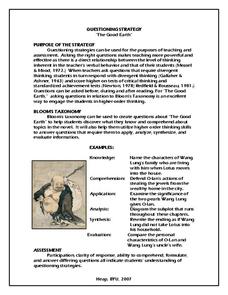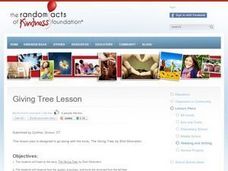Curated OER
Stones, Bones & Telephones: Analyzing Artifacts Using Bloom's Taxonomy
Seventh graders define metacognition, Bloom's Taxonomy, and artifacts. They, in groups, try to identify a mystery artifact using the Artifact Analysis sheet. They present their findings to the class.
Curated OER
Mississippi Trial, 1955: A Request Strategy for Questioning
Knowledge, comprehension, application, analysis, synthesis, evaluation. Class members use Bloom's taxonomy to craft six levels of discussion questions for Chris Crowe's novel, Mississippi Trial, 1955. Model questions from Chapter 3, a...
Curated OER
Ordinary People: Cubing Strategy
Readers of Ordinary People employ a cubing strategy based on Bloom’s Taxonomy to analyze, from multiple perspectives, an excerpt from Chapter 10 of Judith Guest’s novel. The excerpt, a rationale and complete directions for the activity...
Curated OER
Using Bloom's Taxonomy in Science
Help your students internalize knowledge by creating activities that utilize higher level thinking skills.
Brigham Young University
Bloom’s Taxonomy: Questions for Harry Potter and the Chamber of Secrets
As part of their study of Harry Potter and the Chamber of Secrets, readers respond to a series of questions based on chapter eight of J.K. Rowling's second novel in the series about the famous young wizard.
Novelinks
The Adventures of Tom Sawyer: Cubing Strategy
The toss of a die determines what questions your pupils will answer in this lesson. Learners respond to questions based on Bloom's taxonomy, discussing The Adventures of Tom Sawyer with classmates along the way. They finish by writing up...
Curated OER
And the Streets Are Paved With Gold
Students explore immigrant experience at Ellis Island, New York, at the turn of the century, and answer questions that challenge them to use thinking skills from various levels of Bloom's taxonomy.
Curated OER
Watching Minds Bloom
Educators can use the Principles of Bloom's Taxonomy as a Guideline for Differentiated Instruction.
Manchester University
Where The Forest Meets The Sea
Join a father and his son as they explore an isolated location off the coast of Australia in the children's book Where the Forest Meets the Sea by Jeannie Baker. Engage young learners in reading this fun story with this series of...
Curated OER
The Old Man and the Sea: Questioning Strategies
Readers learn to ask questions about text with an activity based on Ernest Hemingway's The Old Man and the Sea. As they read, class members craft questions based on Bloom's Taxonomy and then find the answers themselves.
Novelinks
The Good Earth: Questioning Strategy
Readers use Bloom's Taxonomy to create multi-level questions about Pearl Buck's The Good Earth.
Curated OER
Tangerine: Cubing Strategy
Here's an activity that uses a reading comprehension strategy based on Bloom's taxonomy to focus readers' attention on key passages from Edward Bloor's Tangerine. Worthy of a place in your curriculum library.
Novelinks
Maniac Magee: Discussion Questions
Why did they say that? What did they mean? How did they feel? Using the six levels of Bloom's Taxonomy, challenge your young readers to answer the comprehension questions about chapters 41 and 42 of Maniac Magee by Jerry Spinelli. Each...
Curated OER
Analyzing Artifacts Using Bloom's Taxonomy
Seventh graders apply Blooms Taxonomy to analyze a collection of artifacts. They define and discuss the nature of artifacts and work in groups to complete handouts. Students analyze an object (stone pipe) on a mystery artifact analysis...
Curated OER
Out of the Dust: Questioning Strategies
Bloom's Taxonomy is a great way to address the many levels of comprehension. With explanations and examples of each level, you can create questions that focus on knowledge, comprehension, application, analysis, synthesis, and evaluation.
Novelinks
The Book Thief: Cubing Strategy
Whether used to review prior to a reading assessment or as a way to generate ideas for an essay, this activity is sure to encourage critical thinking about Markus Zusak's The Book Thief. Kids create a six-sided question cube with each...
Curated OER
How Groundhog's Garden Grew
Students answer questions based on Bloom's Taxonomy after reading the book, How Groundhog's Garden Grew, by Lynne Cherry. In this reading comprehension activity, students respond to 6 questions, one per taxonomy level, to demonstrate...
Curated OER
Giving Tree Lesson
Students read and respond the book, The Giving Tree. In this literary unit, students listen to the story and discuss the story using Bloom's Taxonomy. Students write a letter of empathy to the tree and observe the changes the tree went...
Curated OER
The Very Hungry Caterpillar
Students read the book The Very Hungry Caterpillar and answer questions. In this Bloom's Taxonomy questioning lesson, students answer knowledge, comprehension, analysis , application and synthesis questions about the book The Very Hungry...
Brigham Young University
Out of the Dust: Cubing Strategy
Imagine using a six-sided cube to encourage readers to analyze a topic in greater depth. Create a cube, label each of the six sides with one of Bloom's comprehension levels, and you're ready to launch a discussion of a text. Although...
Curated OER
Teaching, Engaging, and Inspiring Extraverted Intuitives
Why flipping Blooms Taxonomy is more effective in predominantly- intuitive classrooms.
Curated OER
Classroom Questioning
Students use this lesson to focus on classroom questioning and Bloom's taxonomy. Using the internet, they use the Bloom's taxonomy website to examine their framework on questions. They use this information to develop their experiments.
Curated OER
Questions About Rivers
Students investigate rivers. In this geography lesson, students work in cooperative groups to read about rivers from articles they have collected. Students form questions using Bloom's Taxonomy as a guide.
Curated OER
Exploring Bloom's Taxonomy Through Eric Carle Collage Technique
Students participate in shared readings of Eric Carle's books and investigate the art and story elements. They create a collage and answer questions.

























